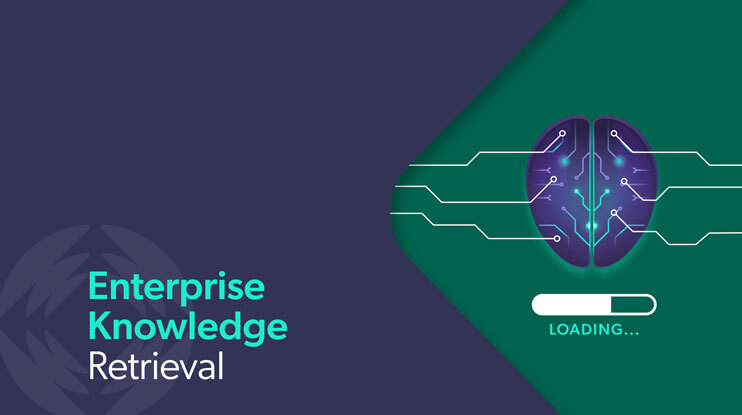Generative artificial intelligence, or GenAI, has captured the attention — and imagination — of just about everyone. GenAI is a media darling, regularly making headlines in major publications like CNBC, TechCrunch, CNET, and Wired. The speed of GenAI adoption, coupled with the sheer volume of new tools (or existing tools with new GenAI features), is creating FOMO within enterprises.
Companies are simultaneously experiencing top-down and bottom-up pressure to transform the way they operate, specifically around information retrieval and usage. Tasks like question answering, data retrieval, and knowledge sharing among employees and stakeholders are examples of what a powerful knowledge retrieval application can do.
One of the most exciting use-cases for GenAI is knowledge discovery. Tasks like enterprise search and customer support can be augmented and supported with generative AI applications. Large language models (LLMs) and natural language processing (NLP) facilitate access to information. This type of human-AI collaboration is a truly exciting and tangible use case for GenAI.
Enterprise Knowledge Retrieval with GenAI
Using GenAI securely – and effectively – to retrieve knowledge in an enterprise setting requires a deliberate approach. Early LLMs were applied to search and knowledge retrieval in sectors like manufacturing, where they helped companies better contextualize and understand historical information for tasks like materials design.
Companies also began using GenAI for customer support tasks within business sectors like retail, travel, and telecom. For example, customer support agents utilized LLMs as a retrieval tool for basic help desk support tasks. It turned out to be a great support tool for tech teams too — with internal IT teams leveraging the GenAI for complex needs like provisioning virtual environments for application testing.
While showcasing GenAI’s potential, these initial use cases had limitations. They relied solely on the LLM’s training data, which could quickly become outdated or lack the specific context required for an enterprise’s proprietary information needs. There were also potential risks around hallucinations and false outputs when not grounded in real data sources.
The next evolution of GenAI would be much more enterprise-ready, accurate, and secure thanks to retrieval augmented generation (RAG) architecture. RAG combined LLMs with an enterprise’s own data sources to significantly improve the accuracy and specificity of knowledge retrieval applications.
Relevant reading: Putting the ‘R’ in RAG: How Advanced Data Retrieval Turns GenAI Into Enterprise Ready Experiences
Combining LLMs and Enterprise Data with RAG
RAG enables enterprises to ground LLMs in their own proprietary data and knowledge sources. This brings “enterprise authenticity” to the generative AI experience by allowing LLMs to generate responses based on the organization’s real and up-to-date information, rather than being limited to just their training data.
Here’s how the RAG process works:
- When a user submits a query, it’s processed by a language model that generates an “embedding” – a numerical representation that captures the semantic meaning of the query.
- This embedding is then used by an information retrieval system to identify and retrieve the most relevant content, document, or data from enterprise data sources (e.g., knowledge bases, company websites and intranets, CRMs, etc.)
- The relevant retrieved content is then passed to another LLM, along with the original user query.
- This second LLM ingests and processes both the query and the relevant retrieved information to generate a contextual, up-to-date response grounded in the enterprise’s proprietary data.
RAG combines the predictive power of LLM models with an enterprise’s own vetted and current knowledge sources through an information retrieval process. This allows the LLM to provide accurate, contextual responses tailored to the specific organization, eliminating hallucinations, outdated, or inaccurate information – issues that plague unsupported LLMs.
RAG can go even farther in producing meaningful information by layering in predictive AI capabilities and rich contextual signals about the user or query. The RAG architecture injects this additional contextual data about the user into the prompt sent to the language model.
For example, it might use a customer’s recent purchase history from your CRM system, or internal forecasting data to assess likelihood of customer churn.
Implementing RAG for Knowledge Retrieval
There are some important things to consider when implementing RAG for enterprise knowledge retrieval. Starting with getting your data sources in order, here are some key best-practices:
- Organize your data – Data sources must be well-organized, with knowledge structure and knowledge source considered from the start. Since disorganized or unstructured data can slow down GenAI implementation, it’s important that relevant data sources are accessible, and each knowledge unit is chunked properly.
- Know your approach – Building in-house can lead to cost overruns, integration issues, and prolonged development times. Partnering with an expert ensures smooth implementation and integration of GenAI into your existing knowledge retrieval processes, workflows, and technology, mitigating these risks.
- Implement safety protocols – Build reliable data privacy and security approaches so external knowledge sources don’t inadvertently expose sensitive information. Having your data in order includes managing access controls over what content the LLM can ingest. You can (and should) also set up user access restrictions that expose different users to different content types. This protects sensitive data from being seen by unauthorized personnel.
- Iterate and update – Strategies for continuously updating and maintaining relevant knowledge sources is vital. Again, how you “chunk things down” is very important since LLMs have expanding context windows.
- Create a GenAI knowledge retrieval culture – Focus on the cultural and change management aspects of implementing GenAI for knowledge retrieval. Engage your broader organization to share ideas about AI and generative AI. This builds confidence in the technology and encourages a mindset of continuous adaptation.
The Future of GenAI-assisted Knowledge Retrieval
As powerful as current RAG architectures are, the future of generative AI for enterprise knowledge retrieval looks even more transformative. We’re poised to go far beyond retrieving information and bringing it back to the end user.
The next generation of GenAI — agentic AI — has the potential to access external systems and take actions there. For example, GenAI could automatically update customer records in CRM systems, trigger workflows in project management tools, or pull data from external databases to enrich reports.
However, enterprises must also be prepared for implementation challenges, such as ensuring data privacy, integrating with legacy systems, and training employees to effectively use these advanced tools. Addressing these challenges proactively will be key to realizing the full potential of GenAI, and engaging with a trusted partner can mitigate the risk taken on.
Curious about these challenges? Take a deeper look in our free ebook, CIO Headaches: 5 Challenges & Solutions to Implementing GenAI.
Dig Deeper
Ready to speak with a vendor who’s helped countless numbers of companies excel in crafting digital experiences? Schedule a meeting with one of our AI search experts today.


